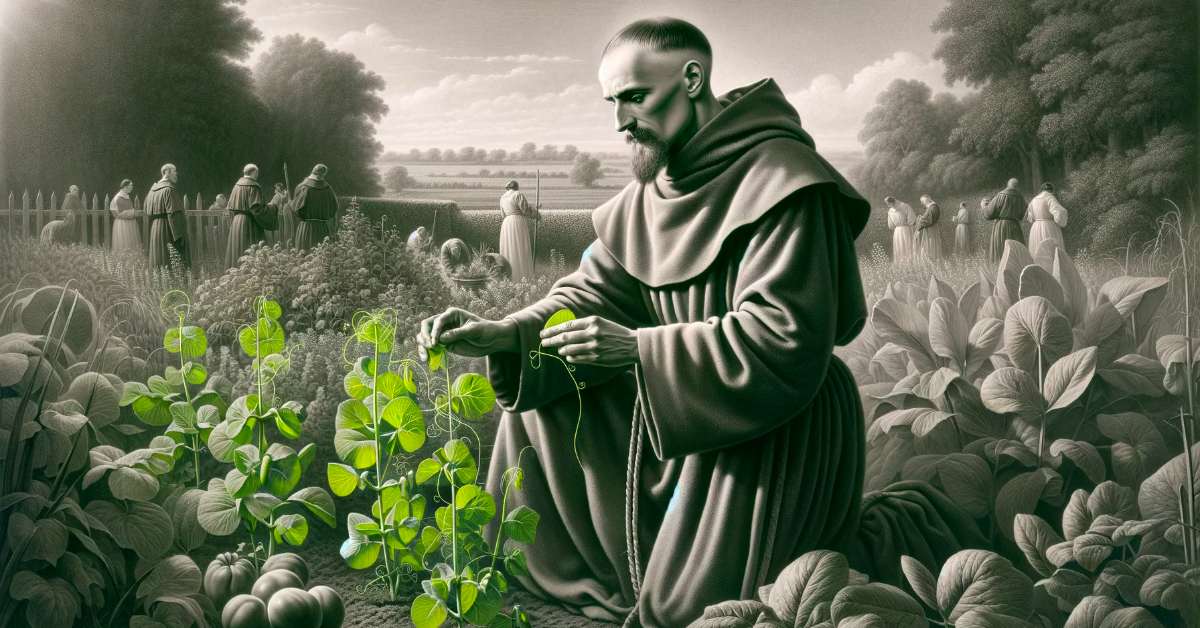In the annals of scientific discovery, few have had as enduring and profound an impact as Gregor Mendel. Often hailed as the father of modern genetics, Mendel’s journey from a humble background to the pinnacle of scientific acclaim is a story of intellectual pursuit, unwavering dedication, and groundbreaking insights.
This biography delves into the life of a man whose curiosity about the natural world transformed our understanding of heredity and laid the foundation for the field of genetics. From his early life in a rural village to his years as a monk with a penchant for scientific inquiry, and onto his revolutionary experiments that reshaped biological sciences, we explore the multifaceted life of Gregor Mendel.
Alongside his scientific achievements, we also address the controversy surrounding his research, offering a holistic view of a figure who is as enigmatic as he is esteemed.
Mendel’s Early Life and Monastic Commitment
Born in 1822 in a small village in the Austrian Empire (now part of the Czech Republic), Johann Gregor Mendel was a child endowed with a curious mind and a passion for learning. Growing up in a farming family, Mendel developed an early interest in plants and nature, which later played a crucial role in his scientific experiments.
Despite financial hardships, Mendel’s academic brilliance shone through, allowing him to pursue his studies in physics and later, in theology, at the University of Vienna.
In 1843, seeking a life dedicated to education and inquiry, Mendel joined the Augustinian Abbey of St. Thomas in Brno. He adopted the name Gregor upon entering the monastery. His life in the monastery was pivotal, as it provided him with the intellectual environment and resources necessary for his groundbreaking research.
The Birth of Genetics: Mendel’s Groundbreaking Work
In the serene gardens of the St. Thomas Abbey, Gregor Mendel embarked on a scientific journey that would forever alter the course of biology. His fascination with heredity led him to choose the common pea plant (Pisum sativum) as his research subject, a decision that proved to be remarkably insightful.
The Experimental Approach

Mendel’s approach was methodical and meticulous. He chose pea plants because they had distinct and easily observable traits, and their reproduction could be easily controlled. Over years, he cross-pollinated pea plants with contrasting traits — tall with short, smooth with wrinkled, green with yellow — and meticulously recorded the outcomes over successive generations.
What set Mendel’s work apart was his application of mathematical analysis to biological questions. By counting and categorizing the offspring of these plants, Mendel was the first to apply statistical methods to the study of heredity.
The Laws of Inheritance
From this extensive experimentation, Mendel derived two fundamental principles, which later became known as Mendel’s Laws of Inheritance:
- The Law of Segregation: This law states that during the formation of reproductive cells (gametes), the paired hereditary factors (now known as genes) segregate so that each gamete carries only one factor for each trait. This explained how traits could disappear in one generation and reappear in the next.
- The Law of Independent Assortment: Mendel found that different traits are inherited independently of one another, providing they are on different chromosomes. This law revealed how new combinations of traits could appear in offspring, a principle that underlies genetic variation.
The Significance of Mendel’s Findings
Mendel’s findings were revolutionary because they challenged the prevailing theories of inheritance, which were largely based on blending (the idea that offspring have a mix of their parents’ traits). Instead, Mendel showed that traits are inherited as discrete units, later known as genes. His work laid the groundwork for understanding genetic diversity, mutation, and the very mechanism of evolution.
Additionally, Mendel’s methodology itself was groundbreaking. He demonstrated the importance of quantitative analysis in biological research, a practice that was not common at the time. His work was a precursor to the modern scientific method in biology, emphasizing the importance of rigorous experimentation and statistical analysis.
Beyond Pea Plants
The implications of Mendel’s work extended far beyond his pea plants. They provided the first clear conception of the fundamental units of heredity and set the stage for the discovery of chromosomes and DNA. His laws of inheritance became central to the study of genetics, influencing a wide range of biological disciplines from evolutionary biology to medical genetics.
Despite the initial neglect of his work, Mendel’s discoveries later became the cornerstone of the new science of genetics in the early 20th century, profoundly influencing our understanding of biology and laying the foundation
for the development of genetic engineering and biotechnology. His insights have not only illuminated the mechanics of inheritance in all living organisms but also opened the door to advancements in agriculture, medicine, and our understanding of human diseases.
The Enduring Impact
Mendel’s legacy in genetics is immeasurable. His work symbolizes the transformation of biology into a quantitative science. It established the patterns of inheritance that explain the diversity of life and laid the groundwork for solving complex biological mysteries. Today, his principles are fundamental to the study of genetics, taught as foundational knowledge in biology classes worldwide.
The birth of genetics, as pioneered by Gregor Mendel, represents a pivotal moment in scientific history. It stands as a testament to the power of observation, experimentation, and the mathematical analysis of biological phenomena. Mendel, a monk in a secluded monastery, through his humble pea plants, revealed the fundamental principles that govern the diversity of life itself.
Recognition and Controversy
Initially, Mendel’s findings, published in 1866 as “Experiments on Plant Hybridization,” went largely unnoticed. It wasn’t until the turn of the 20th century that his work was rediscovered, affirming his status as the father of modern genetics.
However, his research wasn’t without controversy. In the late 20th century, some historians and scientists speculated that Mendel’s data might have been too perfect, leading to suspicions of data fabrication. Critics argued that his results fit the expected ratios almost too well, suggesting possible manipulation.
Nonetheless, numerous scientists and statisticians have defended Mendel, attributing any discrepancies to the limited understanding of statistical variance during his time and the selective reporting of data, a common practice in the 19th century.
Gregor Mendel: Science and Faith Intersecting
Balancing Monastic Life and Scientific Inquiry
Of course, Mendel was also a devoted Augustinian monk. This dual identity raises intriguing questions about the interplay between his religious convictions and his scientific pursuits,
Mendel’s life in the monastery was not just a retreat into spirituality; it was also a gateway to academic and scientific exploration. The Augustinian order, to which Mendel belonged, had a tradition of encouraging intellectual pursuits, including science.
No Direct Conflict with Church Doctrine
Importantly, there is no record of Mendel experiencing any direct conflict between his scientific findings and his religious beliefs. The Catholic Church, during Mendel’s time, did not have any specific doctrines opposing the study of heredity or the patterns of genetic inheritance that Mendel proposed. His research on pea plants was seen primarily as a scientific endeavor rather than a theological statement.
In fact, Mendel’s scientific work can be seen as an extension of his monastic life’s contemplative aspects. His approach to science was methodical and patient, much like the approach one would expect in monastic practices. The environment of the monastery provided him with the time and space to conduct his experiments without the pressures often found in secular academic circles.
The Broader Scientific and Religious Context
During Mendel’s time, the broader scientific community was beginning to grapple with questions about evolution and the origin of species, primarily due to Charles Darwin’s work. These topics were more contentious from a religious standpoint, as they directly touched upon the creation narrative prevalent in religious doctrine. However, Mendel’s work, focused on the mechanisms of inheritance rather than the origin of species, did not seem to directly challenge these narratives.
Moreover, Mendel’s research was largely unknown to the broader scientific community until after his death, and it did not play a part in the contemporary debates between science and religion. His findings were rediscovered and gained significance in the early 20th century, a time when the relationship between science and religion was being viewed through a different lens.
A Harmony of Pursuits
In conclusion, Gregor Mendel’s story is an example of how scientific inquiry and religious faith can coexist harmoniously within the same individual. His role as a monk and a scientist represents a confluence of spiritual and intellectual pursuits, reflecting a worldview where the study of the natural world is seen as complementary to religious life.
While his work did not spark any direct controversy with church doctrines during his lifetime, it opened doors to new scientific understandings that later generations would grapple with, both scientifically and theologically.
Legacy of Religious Scientist… or a Scientific Monk?
Gregor Mendel’s legacy extends far beyond his pea plants. His discoveries have had profound implications in various fields, from biology to medicine, and have laid the foundation for the study of genetics. His work paved the way for the discovery of DNA and the understanding of genetic disorders, revolutionizing our understanding of inheritance and the very fabric of life.
Despite the controversies, Mendel’s contribution to science remains unblemished. His meticulous approach to experimentation and his ability to perceive patterns in nature have immortalized him as a pioneer and a visionary in the field of genetics.
Conclusion About The Work of Gregor Mendel
Gregor Mendel’s journey from a small village in the Austrian Empire to becoming the father of modern genetics is a testament to the power of curiosity, dedication, and the pursuit of knowledge. His story reminds us of the profound impact a single individual can have on our understanding of the natural world. As we continue to unravel the complexities of genetics, Mendel’s legacy remains an inspiration, stimulating a path of scientific discovery.

